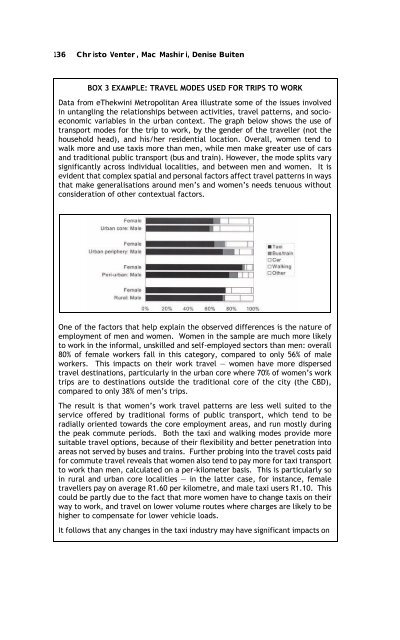Sex, Gender, Becoming - PULP
Sex, Gender, Becoming - PULP
Sex, Gender, Becoming - PULP
You also want an ePaper? Increase the reach of your titles
YUMPU automatically turns print PDFs into web optimized ePapers that Google loves.
136 Christo Venter, Mac Mashiri, Denise Buiten<br />
BOX 3 EXAMPLE: TRAVEL MODES USED FOR TRIPS TO WORK<br />
Data from eThekwini Metropolitan Area illustrate some of the issues involved<br />
in untangling the relationships between activities, travel patterns, and socioeconomic<br />
variables in the urban context. The graph below shows the use of<br />
transport modes for the trip to work, by the gender of the traveller (not the<br />
household head), and his/her residential location. Overall, women tend to<br />
walk more and use taxis more than men, while men make greater use of cars<br />
and traditional public transport (bus and train). However, the mode splits vary<br />
significantly across individual localities, and between men and women. It is<br />
evident that complex spatial and personal factors affect travel patterns in ways<br />
that make generalisations around men’s and women’s needs tenuous without<br />
consideration of other contextual factors.<br />
One of the factors that help explain the observed differences is the nature of<br />
employment of men and women. Women in the sample are much more likely<br />
to work in the informal, unskilled and self-employed sectors than men: overall<br />
80% of female workers fall in this category, compared to only 56% of male<br />
workers. This impacts on their work travel — women have more dispersed<br />
travel destinations, particularly in the urban core where 70% of women’s work<br />
trips are to destinations outside the traditional core of the city (the CBD),<br />
compared to only 38% of men’s trips.<br />
The result is that women’s work travel patterns are less well suited to the<br />
service offered by traditional forms of public transport, which tend to be<br />
radially oriented towards the core employment areas, and run mostly during<br />
the peak commute periods. Both the taxi and walking modes provide more<br />
suitable travel options, because of their flexibility and better penetration into<br />
areas not served by buses and trains. Further probing into the travel costs paid<br />
for commute travel reveals that women also tend to pay more for taxi transport<br />
to work than men, calculated on a per-kilometer basis. This is particularly so<br />
in rural and urban core localities — in the latter case, for instance, female<br />
travellers pay on average R1.60 per kilometre, and male taxi users R1.10. This<br />
could be partly due to the fact that more women have to change taxis on their<br />
way to work, and travel on lower volume routes where charges are likely to be<br />
higher to compensate for lower vehicle loads.<br />
It follows that any changes in the taxi industry may have significant impacts on
















